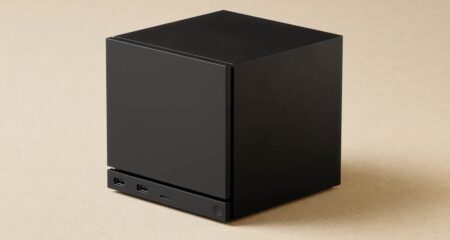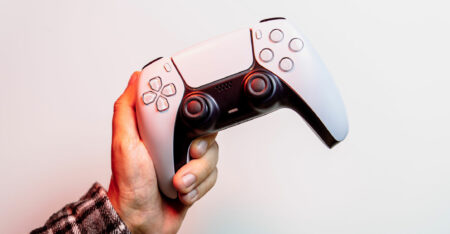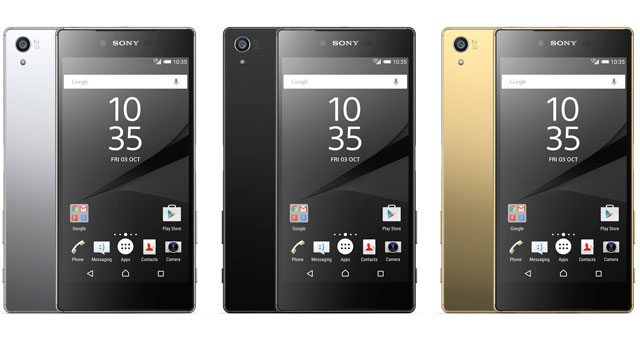
Early in 2013, Sony introduced its very first Xperia Z device to the world. From that point on, these smartphones have grown into a high-end line of products, combining a characteristic design with Sony’s own display technology.
Yet, despite the premium look and feel of the Z line-up, the phones haven’t been profitable for Sony. To find out if the Xperia Z5 Compact has the potential to get Sony on the right path, I thoroughly tested the device and discovered its pros and cons.
Design: slimline and sturdy
For a high-end Android smartphone, Xperia Z5 Compact is actually surprisingly small. Sony calls this design “omni-balance” and has been implementing it from the beginning of the Xperia Z devices. Since then, the company has enhanced and refined each design iteration, ultimately ending up with the current Z5 range.
 Compared to its predecessor, the Z3 Compact, the back of the Z5 Compact is not as smooth and has been replaced by something Sony likes to market as “frosted glass”. The end result is a phone that won’t easily slide out of your hand and is less prone to show greasy fingerprints. The downside is it doesn’t look and feel like glass, therefore slightly diminishing the device’s premium image.
Compared to its predecessor, the Z3 Compact, the back of the Z5 Compact is not as smooth and has been replaced by something Sony likes to market as “frosted glass”. The end result is a phone that won’t easily slide out of your hand and is less prone to show greasy fingerprints. The downside is it doesn’t look and feel like glass, therefore slightly diminishing the device’s premium image.
The front of the Z5 Compact is covered with scratch-resistant Gorilla Glass, while there are small cut-outs above and below the display for the speakers. The Z5 Compact can produce stereo sound, which is a nice bonus for those that plan to listen to some music, or watch video without earplugs. However, as you’d expect from these small speakers, the sound is tinny. They are, however, able to produce a pretty high volume without distortion.
Cheaper, lower-end smartphones tend to make a cracking sound and bend slightly when enough pressure is applied. That’s not the case with this device. The Z5 Compact feels durable and sturdy. I did, however, detect a tiny space between the rear glass and the outer frame. It’s not the end of the world, but definitely visible and in the long term a spot where dust or bacteria might accumulate.
Compact and high end, a dying breed?
The Z5 Compact is indeed nice and small, which will appeal to many consumers. Its 65mm width is pretty unique in the current high-end smartphone market. The elegant dimensions make the Z5 Compact easy and comfortable to operate with just one hand. When compared to the Z3 Compact, its dimensions have remained mostly unchanged. The Z5 Compact is slightly thicker (8,9mm) than the Z3 Compact’s 8,6mm. The bezels are identical: 25mm in total on the top and bottom and 3,8mm at the sides.
Anybody who is specifically looking for a compact, high-end Android smartphone these days, doesn’t have lot of choice. Sony is pretty much the only major brand that still makes compact yet powerful devices. But the fact that all the other smartphone manufacturers aren’t copying Sony might be a sign of their decreasing popularity.
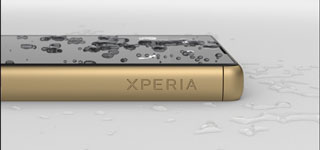 Water and dust
Water and dust
As with previous Xperia Z smartphones, Sony says the Z5 Compact is both waterproof and dustproof. It’s a good thing Sony finally ditched both the annoying 3,5mm jack and USB port flaps. Finally, no more hassle when charging the device, or plugging in headphones. Sony has warned Z5 Compact users, though, that they shouldn’t submerge the device in water or take it for a swim. Briefly rinsing it off, or using it in the rain shouldn’t pose a problem.
I wouldn’t be much of a reviewer if I didn’t put that claim to the test. So I simply made some phone calls while showering. Although the device seemed unharmed by the water drops, operating the touch-sensitive display was dramatic. Like all modern day smartphones, the screen is capacitive by nature, meaning it uses conduction. Water, which is also conductive, complete messes this up. Also, charging the device only works when the port is somewhat dry. It’s a little disappointing that the Z5 Compact doesn’t offer a higher level of water resistance, but at least it offers some form of protection against liquids and dust.
Fingerprint reader
The Z5 Compact has something I haven’t seen before on a smartphone: a side-mounted fingerprint reader. The actual sensor is integrated in the Z5 Compact’s power button. Although I couldn’t put my finger on what exact sensor-model Sony decided to use, the only known manufacturer of these side buttons is a Swedish company called Fingerprint Cards. The firm also produced the fingerprint sensors for some Nexus models and various other brands.

During common, day-to-day use, the fingerprint reader works very well. You do need to press the button initially to wake the phone, before it starts scanning your fingerprint. The location of the fingerprint reader is ideal, since the side is where you automatically place a finger, no matter if you’re left- or right-handed. As a result, picking up the phone and unlocking it becomes a single, intuitive movement. The side position of the fingerprint sensor also facilitates unlocking the Z5 Compact while it’s lying flat on a table or desk.
The relative small size of the fingerprint sensor does come with two drawbacks. Because there is less surface when compared to sensors on bigger phones, it takes longer to configure and calibrate. Luckily, that’s just a once-off procedure. The second flaw is how the sensor reacts to moisture. It takes only a small amount of water on the sensor to prevent it from recognizing your fingerprint.
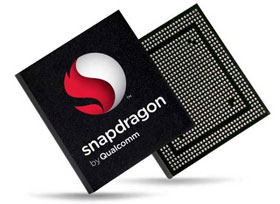 Hardware competes with the big boys
Hardware competes with the big boys
The Z5 Compact uses the Qualcomm Snapdragon 810 system on a chip (SoC) as its beating heart. Not only is this one of the most common SoCs in today’s high-end smartphones, it’s also a component that’s surrounded by some controversy. Even before it appeared in devices, the 810 chip was plagued with some serious heating problems. Sony’s Xperia Z3+, for instance, could shoot 4K video, but the camera app simply shut down after a few minutes due to the Snapdragon 810 overheating.
With the Z5 Compact, those problems belong in the past. The outer hull dissipates heat a lot better, for one thing. The octacore Snapdragon 810 itself houses four energy-efficient Cortex A53 cores running at 1,5 GHz and four Cortex 2GHz A57 cores for the more demanding tasks. The 810 switches between the cores to save energy and thus producing less heat. This is known as big.LITTLE technology. That same 810 SoC features Qualcomm’s Adreno 430 graphics processing unit, which is currently the most powerful GPU made by the company.
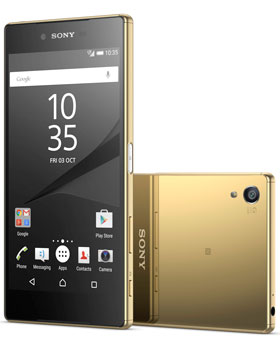
In addition, the Z5 Compact features 2GB of RAM (standard/premium Z5: 3GB) and 32GB of internal storage of which Sony’s version of Android takes up a hefty 10GB, leaving only 21GB for user content. It’s a good thing, then, that the Z5 Compact supports microSD cards of up to 200GB in size. The device supports 4G+ mobile networks, Bluetooth 4.1, near-field communication technology and even the latest 802.11ac Wi-Fi networks for higher transfer speeds.
The Geekbench 3 (multicore) test clearly shows that the Z5 Compact can successfully compete with the big boys, like the new iPhone 6s and standard Z5. Samsung’s Galaxy S6, however, still proves to be the fastest of the lot. The AnTuTu 5 benchmark again shows the Samsung S6 to be king of the hill, with the Z5 and Z5 Compact not far behind. Finally, I ran 3DMark (Ice Storm Unlimited), which primarily focuses on a device’s graphical capabilities. This test shows that the Z5 Compact can almost match the powerful iPhone 6s.

Battery life: shorter than its predecessor
The relatively high-capacity 2 700mAh battery and low screen resolution of 1 280×720 pixels should, at least in theory, be good for an impressive battery life.
Unfortunately, Sony’s Compact range of smartphones is victim to the “Snapdragon-Cortex effect”. Qualcomm’s hasty transition to 64-bit ARM Cortex cores, instead of staying true to their own design, means they painfully needed to compromise on energy consumption. As a result, all high-end smartphones currently on the market using the Snapdragon 810 chip show a clear decrease in battery life.
To find out what the actual damage is, I ran two separate tests. The browser test scrolls through a whole list of sites until there is no more power left. Lasting seven hours and 30 minutes, the Z5 Compact’s battery life is not particularly good. Nor is it terrible bad. It is, however, strange to see that its predecessor lasts two hours longer in the exact same test using a lower-capacity, 2 600mAh battery.
The video test shows the same mediocre results, with the iPhone 6s, Z3 Compact and Galaxy S6 holding out (considerably) longer. At the end of each day, the Z5 Compact definitely needs to be connected to a charger. Speaking of which, the Z5 Compact fully supports Qualcomm’s QuickCharge 2.0 technology. Unfortunately, Sony’s bundled charger does not.
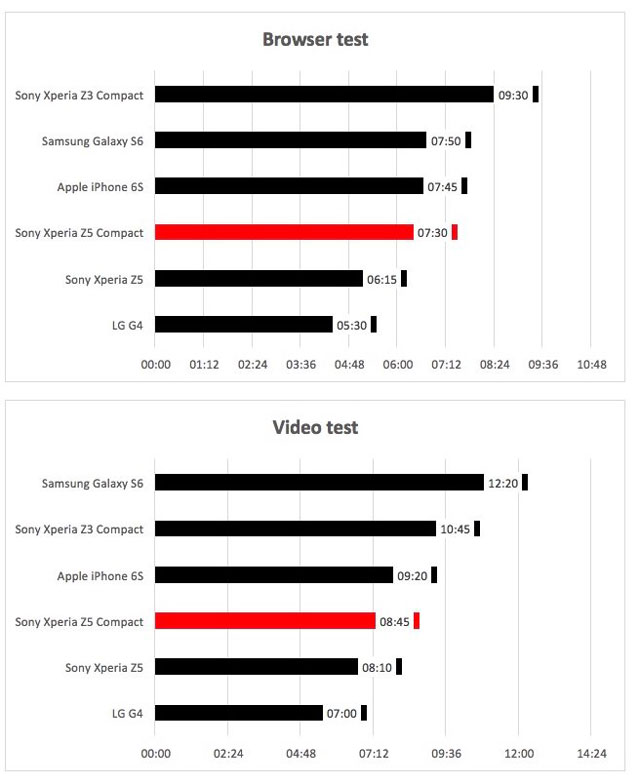
Screen: room for improvement
The Z5 Compact’s screen seems unchanged when compared to the Z3 Compact. It features a 4,6-inch IPS (in-plane switching) LCD able to show off the 1 280×720 pixels at a 319ppi density. Sony could have decided to uses a 1 920×1 080 full-HD screen, but wisely chose not to in order to prevent an even shorter battery life. Because of the relatively low screen resolution, individual pixels can be seen with the naked eye if you look very closely. For regular day-to-day use, most users won’t even notice.
The Z5 Compact’s maximum brightness level of 620cd/m² is excellent. I haven’t come across many phones that can display a similar or higher level of screen brightness. As a result, you can comfortably read screen content in direct sunlight. The contrast ratio of 915:1 is somewhat similar to that of the Z3 Compact. Colours aren’t as vivid and alive as you might expect from high-end smartphones these days. Nonetheless, for most people, the screen will be good enough. However, if you’re one of those photo fanatics that settle for nothing less than very accurate colour reproduction, you should steer clear of this smartphone.

Camera: pretty good
The 23-megapixel rear camera on the Z5 Compact uses a Sony 1/2,3-inch Exmor CMOS RS sensor. It is accompanied by a f/2,0 lens and 192-point phase-detection autofocus, which should deliver the correct focus at warp speed. And it actually does, given that there is sufficient light available. It’s a shame, then, that the device isn’t equipped with superior optical image stabilisation technology like a lot of other high-end smartphones are. Instead, it relies on less effective software algorithms, also called digital image stabilisation, to compensate for trembling hands.
The main camera app that Sony preinstalled on the Z5 Compact is a mixed bag. It offers a lot of preset modes, functionality and filters, but when put in manual mode, things like shutter time, ISO values and shooting in RAW format simply can’t be configured — a missed opportunity. Nonetheless, the Z5 is able to shoot in gorgeous 4K, panorama and slow-motion modes and even features some gimmicky augmented reality options. The AR tool is a real battery and resource hog, though.
The bottom line is that the rear camera on the Z5 Compact, and the whole Z5 range for that matter, is the best Sony smartphone camera so far. It is, however, not the cream of the crop since it doesn’t beat the picture quality generated by Samsung’s Galaxy S6.
The front-facing camera on the Z5 Compact has a maximum resolution of 5,1 megapixels, but shoots at only 3,8 megapixels by default, producing 2 592×1 458 images. It features a f/2,4 lens aperture, ultimately resulting in a mediocre overall image quality. Nonetheless, it is good enough for a decent selfie or Skype-conversation.

In summary
So, can the Z5 Compact match its big brother? Yes, it most definitely can. It offers the same premium design and excellent camera. The Z5 Compact also delivers roughly the same performance and even slightly longer battery life. The screen’s contrast ratio and colour reproduction leave some room for improvement, though. On the other hand, display brightness is excellent and the side-mounted fingerprint reader works like a charm.
Anybody looking for a compact, high-end Android smartphone will find the Z5 Compact to be an excellent choice. TechCentral’s score? A solid eight of 10. — © 2015 NewsCentral Media
- The Sony Xperia Z5 is available now. Expect to pay R9 499 without a contract


